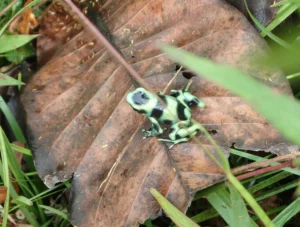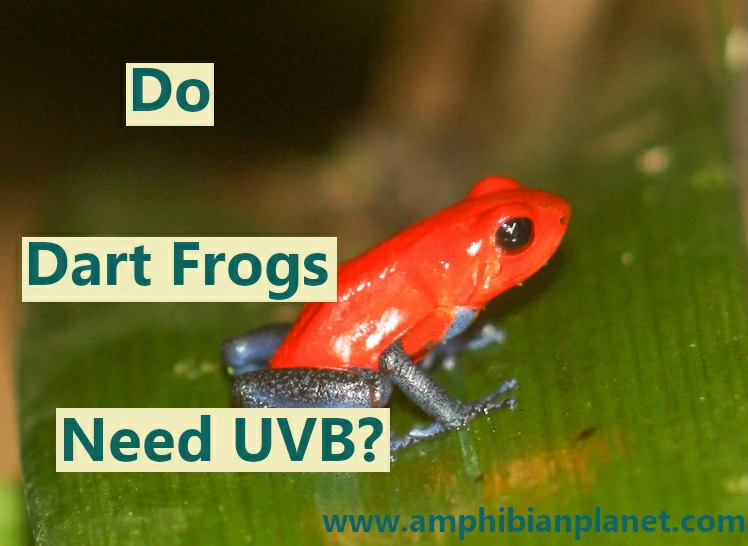All living things on the surface of the planet are exposed to ultraviolet light to some extent. Diffused and reflected UVB will penetrate into deep shade, so even creatures on the floor of thick rainforests may be exposed to small amounts of UVB. Exposure to UVB allows poison dart frogs to synthesize vitamin D in their skin, which is vital for their proper health.
In general, captive poison dart frogs benefit from UVB light that mimics the level of UV exposure they would get in the wild. Many poison dart frog species live on the floor of thick primary rainforests, but they are still exposed to diffused and reflected UVB permeating the rainforest shade.
That being said, it’s important to note that many poison dart frog species can survive without UVB lighting, provided that adequate levels of vitamin D3 are provided in the diet.
Many keepers have raised and bred several species of poison dart frogs in captivity, in the absence of UVB light – which proves that UVB is not strictly essential for all species.
However, it’s still best practice to provide low levels of UVB lighting for optimal health and wellbeing
Understanding UV light
All of the energy from the sun that reaches the earth arrives as solar radiation. This solar radiation is transmitted in waves or particles at different wavelengths and frequencies – known as the electromagnetic spectrum.
The spectrum is generally divided into radio waves, microwaves, infrared (IR), visible light, ultraviolet (UV), X-rays, and gamma-rays.
Ultraviolet (UV) light has shorter wavelengths than visible light, which makes it invisible to the naked eye.
It is commonly subdivided into ultraviolet A (UVA), ultraviolet B (UVB), and ultraviolet C (UVC), based on their wavelengths.
All of the UVC and most of the UVB radiation (about 95%) is absorbed by the earth’s ozone layer, so nearly all of the ultraviolet radiation received on Earth is UVA.
Amphibians need both UVB and UVA light from the sun to live healthy lifestyles but do not need UVC.
- UVA light helps regulate behaviors such as feeding, diurnal movement, mating, and similar activities. Frogs will generally have a positive response if exposed to UVA light. Increased reproductive behavior, feeding, and activity levels can often be seen.
- UVB light allows frogs to synthesize vitamin D3 inside their skin. Vitamin D3 helps the frog to absorb calcium in the gastrointestinal tract, which is crucial for bone structure and growth.
- UVC light is not required for amphibians, and at high levels, it can be harmful to most animals.
Only the sun can provide all the radiation wavelengths necessary for amphibian metabolism from a single source.
However, in captivity, it’s recommended to somewhat replicate this through a variety of different types of artificial light sources.
UVB For Captive Frogs
UVB plays an important role in the vitamin D3 metabolism of many captive frogs. Vitamin D3 allows calcium to be absorbed from the gastrointestinal tract, as well as having other important functions.
Vitamin D3 deficiency in frogs can lead to low calcium levels which can result in bone density issues, poor digestive tract motility, muscle weakness, reduced immune system, and neurological symptoms such as twitching and seizures.
One of the most common conditions is called metabolic bone disease (MBD) where the bones lose their calcium stores and become very weak and rubbery.
Do Poison Dart Frogs Really Need UVB?
In general, captive poison dart frogs will benefit from a UVB light that mimics the level of UVB exposure they would get in the wild.
Most poison dart frogs live in primary rainforests, with dense canopies where much of the direct sunlight is absorbed by the foliage.
However, they are still exposed to solar radiation throughout the day in light gaps, and sunflecks under forest canopies.
Sunflecks are brief patches of sunlight in the understory of an ecosystem. They are caused by either wind moving branches and/or leaves in the canopy or as the sun moves during the day.

Since poison dart frogs are naturally exposed to UVB in the wild, captive frogs may also befit from low levels of UVB lighting.
That said, many poison dart frog species have been proven to be able to survive and stay healthy with no access to ultraviolet light, provided that adequate levels of vitamin D3 are provided in the diet.
Poison dart frogs are generally insectivores, and in nature, obtain a considerable proportion of their vitamin D3 from their diet.
Dart frog keepers commonly choose not to provide UVB for their frogs, and instead supplement their diet with vitamin D3.
However, even though poison dart frogs can survive without UVB, they may still benefit from the ability to experience at least some gentle UVB during daylight hours.
How to Provide UVB Light for Dart Frogs
UVB can be provided by several types of lights. There are bulbs that provide heat, bulbs that provide light, and bulbs that provide both.
In the United States, UVB bulbs are generally available in 2.0, 5.0, and 10.0.
10.0 UVB bulbs are typically used for reptiles that thrive in full sun environments, such as deserts, for example, bearded dragons.
5.0 bulbs are generally used for reptile species such as many chameleons, that live in forests, where much of the sunlight is absorbed by the foliage.
UVB 2.0 lamps that run fairly cool are preferred for most dart frog species because of their generally low UV-B and temperature requirements.
The UVB bulb should be housed in a reflective fixture directly above the terrarium, and the frog should not be able to get too close to the lamp.
Remember to provide a few places your frog can hide in to escape from the light. You can do this by placing branches or plants in a way to provides shaded areas.
UVB bulbs should be used during the day and turned off during the night to mimic daytime and nighttime.
Every type of frog has slightly different needs but a general rule of thumb is to keep the UVB light on for 12 – 14 hours and off for 10 – 12 hours.
UVB Bulbs Degrade Over Time
It’s important to note that all UVB sources degrade over time. As the bulb degrades, visible light output can remain the same – but UVB production will slowly begin to drop off as soon as the bulb is turned on.
UVB bulbs have a coating inside the glass that allows them to emit UVB lighting. This coating wears off over time and the bulb will stop producing the UVB your frog needs.
At this point, the bulb will serve no other purpose than providing visible light and must be replaced for the continued health and well-being of your pet.
The rate at which bulbs degrade depends greatly on the type of bulb, and how long the bulb is being used per day.
In general,
- Linear and compact fluorescent bulbs will need to be replaced about every 6 months
- Mercury Vapor bulbs will typically last 1 year with a wire ballast
- Metal Halide bulbs can last up to 2 years
It’s a good idea to monitor the UV output of your bulb with a UV meter. A great one that is popular among many reptile and amphibian hobbyists is the UVB meter sold by Solartech under the brand name “Solarmeter 6.2.”
If you opt to go without a UVB meter, you should consider replacing the bulbs within the time frames recommended by the manufacturer.
UVB Effectiveness and Blocking
As the distance between the UVB bulb and your pet increases, the usable UVB radiation decreases rapidly. Most bulbs provide UV levels and readings at a recommended minimum distance from the bulb.
Make sure to consult the specific manufacturer’s recommendation often found on packaging material, or in a manual or guide found in the box.
In addition, glass and acrylic (also known as Plexiglass) block UVB rays, so if there is any glass or acrylic between your UVB source, and your pet – the pet will not receive any benefit from the UVB bulb.
Also, a screen lid can significantly reduce the amount of UVB available to your frog. In general, the closer or more dense the mesh, the less UVB passes through the screen. It’s a good idea to use as large a mesh size as possible when selecting a screen top for your pet.
When most UVB sources report their UVB output at a certain distance, this reading is often taken with no obstructions between the bulb and the UVB meter.
Can Dart Frogs Receive Too Much UVB?
Excessively high doses of UVB radiation can be harmful, or even lethal to most frog species, including poison dart frogs. This can happen from prolonged exposure to UVB, incorrectly installed UVB light sources or use of UVB light sources with too high an intensity.
It is well-known that in mammals, excessive exposure to the sun’s ultraviolet rays – or their artificially produced equivalent – can be harmful. The situation in amphibians has not been studied in detail but is almost certain to be similar.
Poison dart frogs have very thin delicate skin, and in the wild, they make special effort to avoid exposure to damaging ultraviolet-B radiation.
Although the UV output from many lamps sold for reptile and amphibian use is only a fraction of that found in natural sunshine, all artificial sources of UV radiation must be treated with respect.
Some UV lamps emit very high UV radiation at close range, so the manufacturers’ recommended minimum distances should always be taken seriously.
It is VERY IMPORTANT to ensure that your dart frogs are not exposed to levels of UVB which would be unnaturally high for a wild animal of that species in its normal habitat.
Extra UVB above the requirement for D3 production is of no benefit.
Sources:
Kats LB, Bucciarelli GM, Schlais DE, Blaustein AR, Han BA (2012) Ultraviolet Radiation Influences Perch Selection by a Neotropical Poison-Dart Frog. PLoS ONE 7(12): e51364. https://doi.org/10.1371/journal.pone.0051364
Dr. Robert Browne, Dr. Francis Vercammen, and Rachael E. Antwis (2009). UV-B, Vitamin D3, and amphibian health and behavior (PDF).
National Aeronautics and Space Administration, Science Mission Directorate. (2010). Ultraviolet Waves. Retrieved [June 11, 2023], from NASA Science website: http://science.nasa.gov/ems/10_ultravioletwaves


